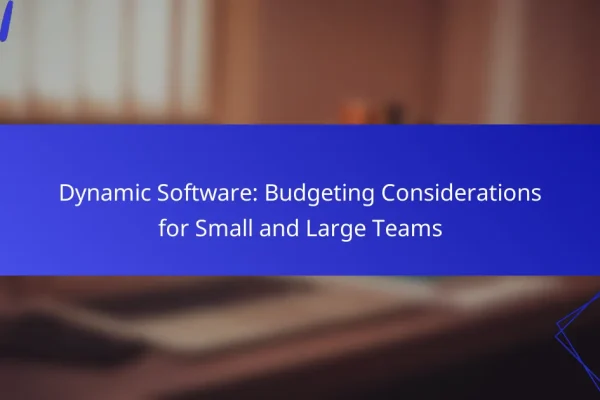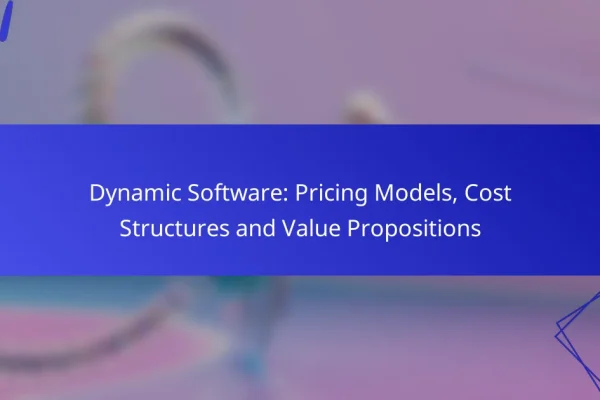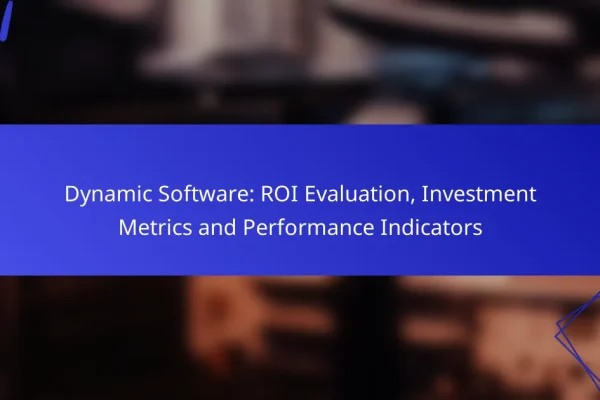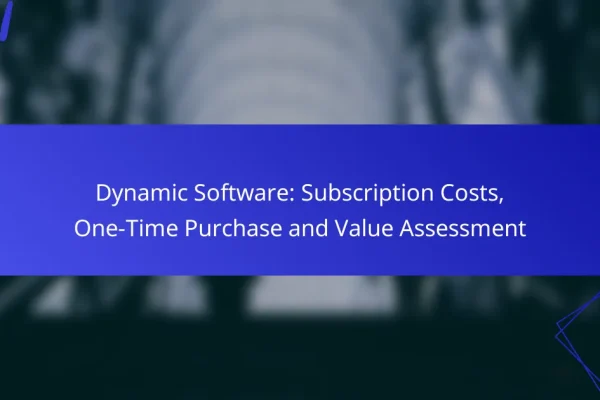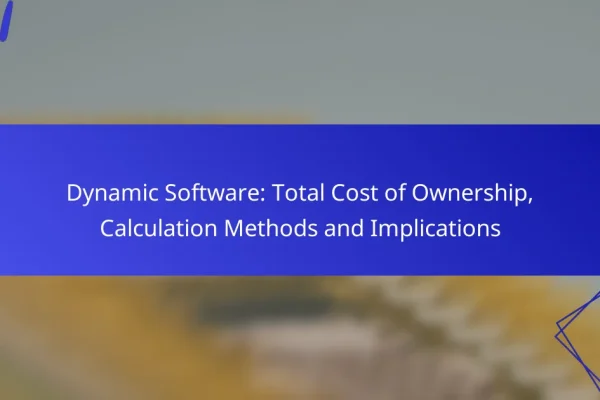What are the dynamic software pricing models?
Dynamic software pricing models are flexible pricing strategies that adapt to market conditions, customer needs, and usage patterns. These models allow businesses to optimize revenue while providing value to customers through various payment structures.
Subscription-based pricing
Subscription-based pricing involves charging customers a recurring fee, typically monthly or annually, for access to software. This model provides predictable revenue for businesses and ensures continuous updates and support for users.
Common examples include software-as-a-service (SaaS) platforms like Adobe Creative Cloud or Microsoft 365, where users pay a set fee for ongoing access. Companies should consider offering different subscription tiers to cater to varying customer needs and budgets.
Pay-per-use pricing
Pay-per-use pricing charges customers based on their actual usage of the software, making it a cost-effective option for those who may not need constant access. This model is ideal for applications with fluctuating demand or specific project-based needs.
For instance, cloud services like Amazon Web Services (AWS) utilize this model, where users pay for storage and computing power based on their consumption. Businesses should clearly communicate usage metrics and potential costs to avoid unexpected charges for customers.
Freemium model
The freemium model offers a basic version of the software for free while charging for premium features or services. This approach helps attract a large user base, allowing companies to upsell advanced functionalities to those who find value in the free offering.
Popular examples include Spotify and LinkedIn, where users can access core features without payment but must subscribe for enhanced capabilities. Companies should ensure that the free version is valuable enough to entice users while demonstrating the benefits of upgrading.
Tiered pricing
Tiered pricing involves creating multiple pricing levels based on features, usage limits, or customer segments. This model allows businesses to cater to a diverse audience, from small startups to large enterprises, each with different needs and budgets.
For example, a project management tool may offer basic, professional, and enterprise tiers, each with increasing features and support. Companies should clearly define the differences between tiers to help customers choose the best option for their requirements.
Flat-rate pricing
Flat-rate pricing charges a single price for access to the software, regardless of usage or features. This model simplifies budgeting for customers and can be appealing for those who prefer straightforward pricing without hidden fees.
Examples include software like Basecamp, which charges a fixed monthly fee for unlimited users and projects. While easy to understand, businesses should ensure that the flat rate reflects the value provided to avoid potential revenue loss from high-usage customers.
How do dynamic pricing models benefit e-commerce businesses?
Dynamic pricing models offer e-commerce businesses the ability to adjust prices in real-time based on various factors, leading to increased competitiveness and profitability. By leveraging data analytics, businesses can optimize pricing strategies to maximize revenue and enhance customer satisfaction.
Increased revenue potential
Dynamic pricing can significantly boost revenue by allowing businesses to set prices based on demand fluctuations, competitor pricing, and customer behavior. For example, during peak shopping seasons, prices can be raised to capture higher willingness to pay, while discounts can be offered during slower periods to stimulate sales.
Implementing dynamic pricing requires careful analysis of market conditions and customer data. Businesses should monitor competitor prices and adjust their own accordingly, potentially leading to revenue increases of 10-30% in competitive markets.
Enhanced customer segmentation
Dynamic pricing enables more effective customer segmentation by tailoring prices to different customer groups based on their purchasing habits and preferences. For instance, loyal customers might receive exclusive discounts, while new customers could be targeted with introductory offers.
By analyzing customer data, businesses can identify segments that respond best to specific pricing strategies. This targeted approach not only improves customer satisfaction but also increases conversion rates, as customers feel valued and understood.
Improved inventory management
Dynamic pricing aids in better inventory management by adjusting prices based on stock levels and demand. When inventory is high, prices can be lowered to encourage sales, while low stock can trigger price increases to maximize profit margins.
Utilizing dynamic pricing tools allows businesses to automate these adjustments, ensuring that inventory turnover rates are optimized. This strategy can help reduce excess stock and minimize losses from unsold items, ultimately leading to a more efficient supply chain.
What factors influence software pricing strategies?
Software pricing strategies are influenced by various factors including market demand, the competitive landscape, the cost of development, and the target audience. Understanding these elements helps businesses set prices that reflect both their value proposition and market conditions.
Market demand
Market demand plays a crucial role in determining software pricing. High demand for a specific type of software can justify higher prices, while low demand may necessitate more competitive pricing to attract customers. Companies should analyze trends and user needs to gauge demand effectively.
For instance, during a surge in remote work, collaboration tools saw increased demand, allowing providers to raise prices. Businesses should monitor market signals and adjust their pricing strategies accordingly.
Competitive landscape
The competitive landscape significantly impacts software pricing strategies. Companies must consider the pricing of similar products offered by competitors to remain relevant. If competitors offer similar features at lower prices, businesses may need to either enhance their offerings or adjust their pricing.
Conducting a competitive analysis can help identify pricing trends and gaps in the market. For example, if a competitor’s product is priced at USD 50 per month, a similar product might need to be priced competitively or offer additional features to justify a higher price.
Cost of development
The cost of development is a fundamental factor in setting software prices. This includes expenses related to labor, technology, and ongoing maintenance. Companies should calculate their total development costs to ensure that their pricing covers these expenses while generating profit.
For example, if the total cost to develop a software product is USD 100,000, and the company aims for a profit margin of 20%, the pricing strategy should reflect this to achieve a sustainable business model.
Target audience
Understanding the target audience is essential for effective software pricing. Different customer segments may have varying willingness to pay based on their needs and budget constraints. Tailoring pricing strategies to specific audiences can enhance sales and customer satisfaction.
For instance, enterprise clients may be willing to pay more for robust features and support, while small businesses might prefer lower-cost options. Companies should segment their audience and consider tiered pricing models to cater to diverse needs.
How to choose the right pricing model for your software?
Choosing the right pricing model for your software involves understanding customer needs, evaluating market trends, and considering scalability. Each of these factors plays a crucial role in determining a pricing strategy that aligns with both your business goals and customer expectations.
Assess customer needs
Start by identifying the specific needs and preferences of your target audience. Conduct surveys or interviews to gather insights on what features customers value most and how much they are willing to pay for them. This understanding will help you tailor your pricing model to meet their expectations.
Consider segmenting your customers based on their usage patterns or budget constraints. For instance, a tiered pricing model can cater to different customer segments, allowing you to offer basic features at a lower price while providing premium features at a higher cost.
Evaluate market trends
Stay informed about current market trends and competitor pricing strategies. Analyze how similar software products are priced and what models are gaining traction in your industry. This can provide valuable benchmarks for setting your own pricing.
Look for emerging trends such as subscription-based models or pay-per-use pricing, which may be more appealing to customers in certain sectors. Adapting to these trends can enhance your competitive edge and attract more users.
Consider scalability
Your pricing model should support the growth of your software business. Think about how your model will scale as your user base expands. For example, a usage-based pricing model can be beneficial for software that experiences variable demand, allowing you to charge customers based on their actual usage.
Additionally, ensure that your pricing structure can accommodate future enhancements or additional features. This flexibility will allow you to adjust prices as your software evolves, ensuring continued customer satisfaction and retention.
What are the challenges of dynamic pricing models?
Dynamic pricing models face several challenges, including customer perception issues and complexity in implementation. These challenges can impact the effectiveness and acceptance of pricing strategies in various markets.
Customer perception issues
Customers often react negatively to dynamic pricing, viewing it as unfair or exploitative. This perception can lead to dissatisfaction and loss of trust, especially if prices fluctuate significantly within short time frames.
To mitigate these issues, companies should communicate transparently about their pricing strategies. Providing clear explanations for price changes can help customers understand the rationale behind dynamic pricing.
Complexity in implementation
Implementing dynamic pricing models can be technically challenging due to the need for sophisticated algorithms and real-time data analysis. Businesses must invest in technology and expertise to effectively manage these systems.
Additionally, organizations should consider the integration of dynamic pricing with existing sales and marketing strategies. A well-coordinated approach can enhance the effectiveness of pricing models while minimizing operational disruptions.
